In this guide, I’ll show you how to make your own ginger bug recipe. You’ll get to create a natural fermented ginger starter step by step. I’ll cover the main ingredients, the steps, and tips for successful ginger bug fermentation. This will help you make probiotic-rich ginger drinks and sodas with your own natural ginger bug.
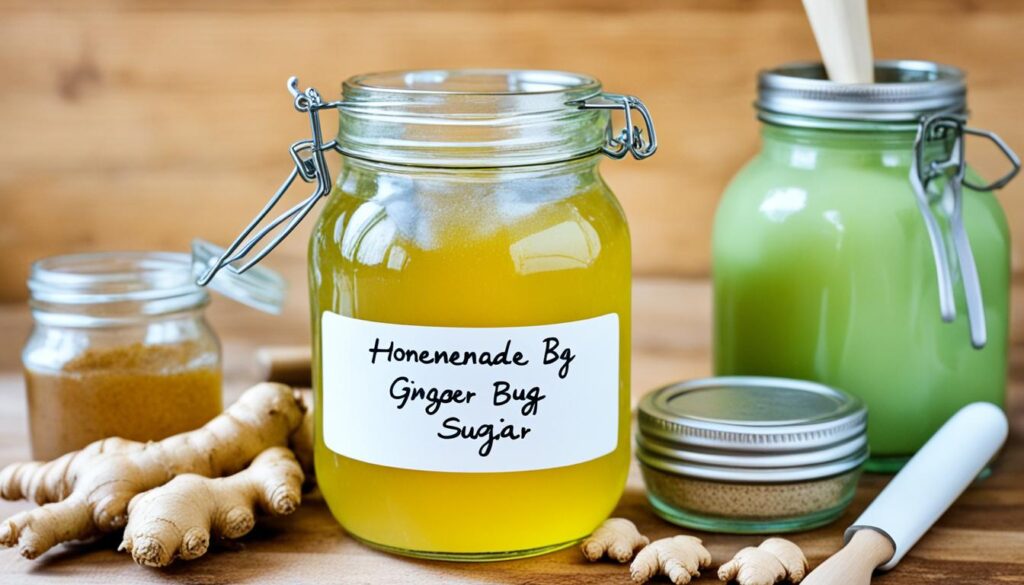
Table of Contents
What is a Ginger Bug Recipe?
A ginger bug recipe is a simple way to make a starter full of probiotics. You only need ginger, sugar, and water. This starter, known as a wild yeast culture, can make many tasty, lacto-fermented drinks. You can make everything from tangy ginger ale to refreshing probiotic drinks.
Creating a ginger bug lets you use sourdough starter-like fermentation. This opens up a world of homemade, gut-healthy drinks.
Introducing the Ginger Bug
A ginger bug is a mix of microbes that live on the sugars and yeasts in ginger and water. As you feed and care for it, it grows into a strong mix of good bacteria and wild yeasts. This mix is perfect for starting your own probiotic drinks or sodas.
Benefits of Homemade Ginger Bug
Creating your own ginger bug has many perks. You get a starter for making lots of tasty, fizzy drinks. Plus, you get to enjoy the health benefits of live probiotics. These drinks are bubbly but don’t have the sugar or fake stuff found in store-bought sodas. They’re a better choice for you and your family.
Continue to Read More: Homemade Ginger Bug Recipe: Easy Guide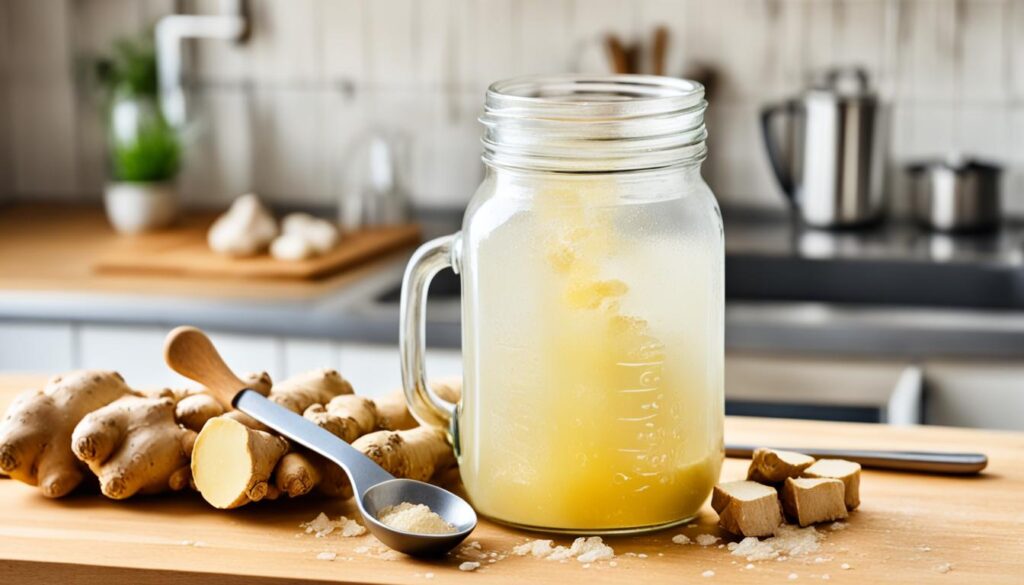
Essential Ingredients for Your Ginger Bug Recipe
Making a homemade ginger bug is easy and fun, needing just a few key items. You’ll need freshly grated ginger, white sugar, and filtered water. These ingredients start the fermentation process, turning your ginger bug into a lively starter.
The ginger brings the yeast and beneficial bacteria needed for fermentation. The white sugar feeds these microorganisms, helping them grow. And the filtered water creates the perfect setting for your ginger bug to grow.
Start with 1 tablespoon of freshly grated ginger, 1 tablespoon of white sugar, and 1 cup of filtered water. You can adjust these amounts based on what you like and the strength of your ginger bug ingredients.
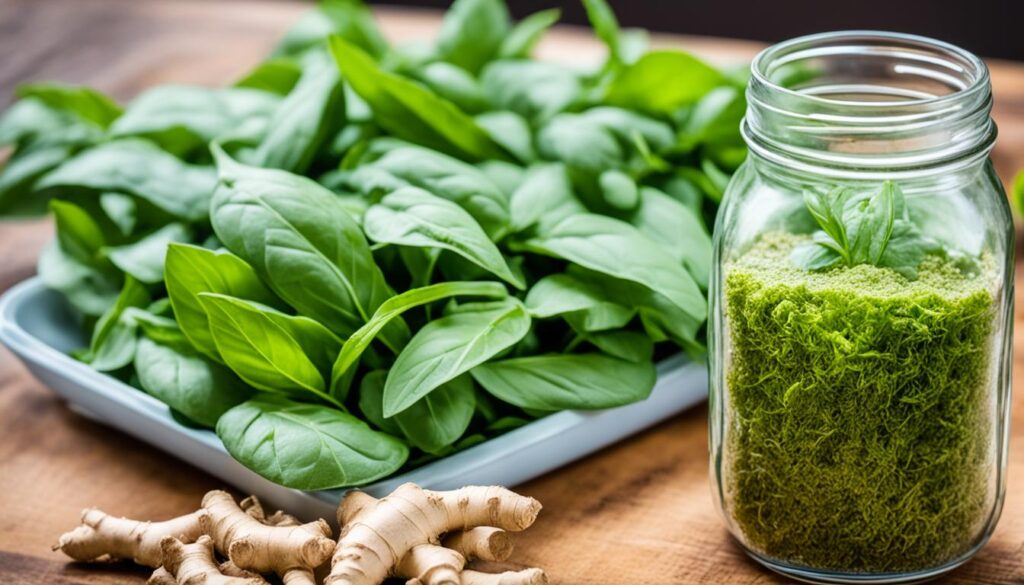
By mixing these three key ingredients, you’re on your way to a thriving ginger bug. This starter can be used to make probiotic-rich drinks and foods. The process of making ginger bug is as fulfilling as the final product.
Step-by-Step Instructions for Creating a Ginger Bug
Making your own ginger bug is fun and lets you use natural fermentation. Just follow these simple steps to start your ginger bug starter.
Day 1: Kickstarting the Fermentation
First, mix 1 cup of filtered water, 1 tablespoon of grated ginger, and 1 tablespoon of white sugar in a clean glass jar. Stir until the sugar dissolves. Then, cover the jar loosely and let it sit at room temperature for 24 hours.
Days 2-7: Feeding the Ginger Bug
For the next 6 days, feed your ginger bug with more ginger and sugar. Every day, add 1 tablespoon of grated ginger and 1 tablespoon of sugar. Watch as it starts to bubble and fizz, showing it’s fermenting. Keep the jar loosely covered and at room temperature.
By day 7, your ginger bug should be bubbly and ready for use in probiotic recipes. You’ve made your own ginger bug starter!
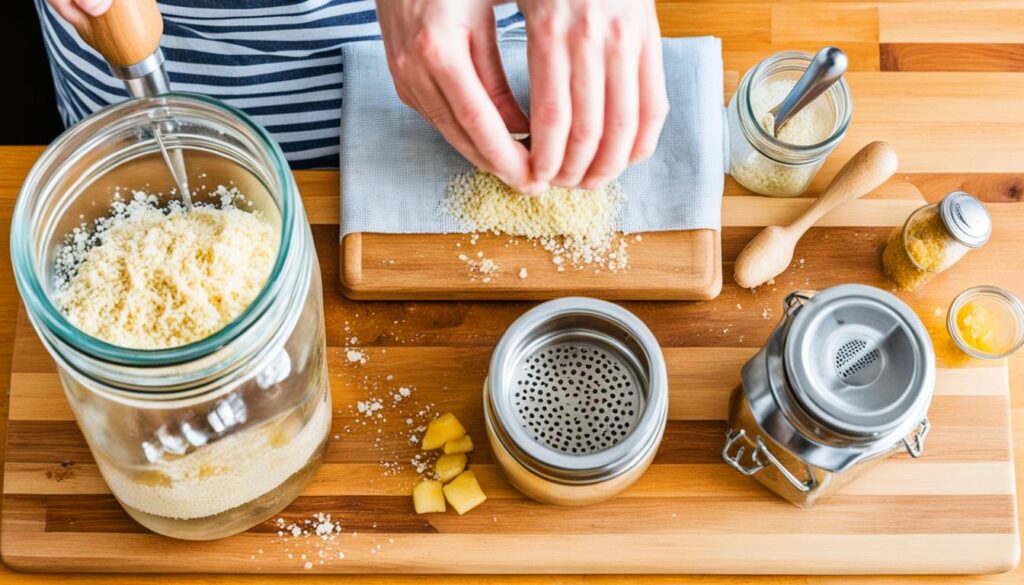
Ginger Bug Recipe: Troubleshooting Common Issues
Making a ginger bug is pretty simple, but you might face some challenges during fermentation. I’ll share tips to fix issues like a slow starter, bad flavors, mold, and more. These tips will help you keep your ginger bug troubleshooting on track and maintain a healthy culture.
A common issue is a slow or stagnant starter. If your bug isn’t bubbling, check the temperature where it’s fermenting. Ginger bugs do best in warm places, between 70-85°F (21-29°C). Make sure it’s in a good spot, and think about using a heating pad if it’s too cool.
Off-flavors, like yeasty or boozy tastes, can happen. This might be from over-fermenting or an imbalance in the bug’s bacteria. Try changing your feeding schedule, using less sugar, or adding new starter to fix the balance.
Seeing mold on your ginger bug is a big deal. Remove the mold, clean the container well, and throw away some starter before feeding it again. Keeping your bug clean and covered can stop mold from coming back.
By fixing these common ginger bug troubleshooting problems, you can keep your starter healthy and ready. This means you can make tasty probiotic drinks and fermented foods easily.
Maintaining Your Lively Ginger Bug
After making your ginger bug, keeping it active is key. You need to feed it regularly to keep it bubbly. This is important for making natural ginger ale, old-fashioned ginger soda, and other fermented drinks.
Feeding Schedule for a Healthy Ginger Bug
Feed your ginger bug a mix of filtered water, sugar, and fresh ginger often. Add this mix every 1-2 days, or less if it eats it fast. When it’s really active, you can feed it just once a week.
In the beginning, you might need to feed it every day. But as it grows stronger, you can feed it less. Watch how it looks and acts to know when to feed it.
Stick to a regular feeding plan to keep your ginger bug strong and ready for use. With a bit of care, this starter can make many delicious, probiotic-rich drinks. It’s the base for making your own natural ginger ale and other fermented goodies.
Creative Ways to Utilize Your Ginger Bug
Using your homemade ginger bug opens up a world of possibilities. You can make more than just ginger ale. Try making root beer, switchel, or even homemade wine or kombucha. The homemade ginger bug is a great base for many probiotic-rich drinks.
Probiotic Ginger Ale and More
A homemade ginger bug is perfect for making ginger ale. It’s fizzy and good for your gut. But why stop there? You can also brew root beer, switchel, wine, or kombucha. The possibilities for fermented beverages are endless.
Whatever you decide to make, your ginger bug will bring a special taste and lots of probiotics. So, get your bug ready and start experimenting. Enjoy making your own tasty, gut-friendly drinks!
Tips for Successful Ginger Bug Fermentation
To make your ginger bug fermentation a success, focus on a few important things. Start with fresh, clean ginger. The cleaner the ginger, the better your results will be. Also, choose unrefined cane sugar or honey for the best flavor.
Keep an eye on how your ginger bug is fermenting. Watch for signs of life in your jar and adjust the feeding as needed. A busy, active ginger bug means your starter is doing well. Keep the temperature right, between 70-85°F, to help the good bacteria and yeast grow.
By following these tips, you’ll create a strong, tasty ginger bug. This starter is perfect for making probiotic drinks. Enjoy the many ways you can use it.
